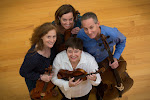Every time we collaborate as music colleagues, the meeting of “minds and hearts” is at the center of that remarkable experience. This has been true through the ages - the most inspired and inspiring musical friendships are intrinsically tied to this connection between minds and hearts.
One of the most famous of all musical affiliations was that of Johannes Brahms, Robert Schumann and Clara Wiek Schumann. Their extraordinary relationship has been described as a love triangle, an extended family, a mentor relationship (Brahms being the younger) and in countless other ways. However one may try to explain it, what is certain is that a great font of inspiration channeled between these three great musicians, fueled by intimate affection, passion, and artistic intensity that they shared.
Serafin String Quartet enjoys the exhilaration and challenge of working closely together – colleagues and friends sharing a deep and personal exchange through the music we seek to know, and that we craft together and share with audiences. It is our great privilege to have the wonderful opportunity to extend our collaborative process to include others, as we will do with Jennifer Campbell, Nina Cottman and Jennifer Stomberg at the Anthony G. Simmons Scholarship Benefit Concert on October 26, 2016 at 7:00pm at The Music School of Delaware. The joy of musical exploration is a deeply individual pursuit. At the same time, it is an enlightening and uplifting exchange – between musicians, and with the audience.
The title of the October 26 concert program “Free But Happy – Inspirational Musical Friendships” is drawn from an exchange between Robert Schumann and Johannes Brahms, who spoke about being “free but alone” or “free but happy.” They incorporated a musical motive for each of these ideas based on the first letters from the German version of each phrase: “frei aber einsam” or (FAE), and, “frei aber froh” (FAF). This was one of a number of musical dialogues that flowed from their compositional intersection through the language of music.
The musical inspiration for October 26 concert: masterworks by two astounding composers - a program of collaborative works that provide colleagues an inspiring musical meeting ground – is our opportunity to share with you, the audience, this “musical offering.” This program also pays tribute to our colleague who passed before us, Tony Simmons (founding violist of Serafin String Quartet), who embodied the best of what it means to be a musician, a colleague, a teacher, a friend, a husband, and a human being. His passing inspired the creation of the Anthony G. Simmons Scholarship Fund at the Music School. The fund provides financial aid so that more people can experience the special and compelling joy of making and experiencing music.
Kate



